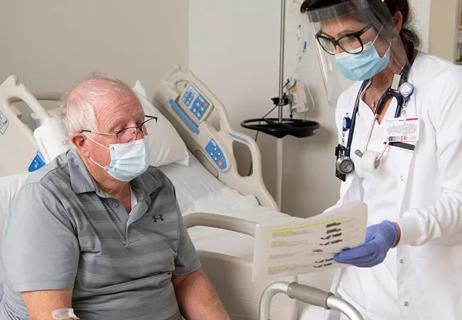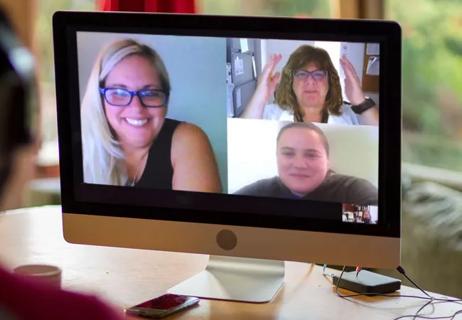Advertisement
Streamlining external staffing leads to efficiencies

Prior to 2012, when a Cleveland Clinic nursing unit needed an agency nurse, the nurse manager or hospital staffing office typically reached out to an external staffing agency. This struck Jennifer Sasala and Meg Duffy, who work in Cleveland Clinic Staffing Resources, as inefficient and uneconomical.
Advertisement
Cleveland Clinic is a non-profit academic medical center. Advertising on our site helps support our mission. We do not endorse non-Cleveland Clinic products or services. Policy
The two thought a standardized approach to external agency staffing could streamline the process, save money and encourage nursing units to consider the institute’s enterprise float pool of more than 200 caregivers. The team brought the idea to nursing leadership and got the green light to go ahead with centralizing the process.
“We wanted to make sure we were optimizing resources we currently had before moving forward with external agency staffing,” says Duffy, MSM, RN, Director of Cleveland Clinic Nurse Recruitment and Cleveland Clinic Staffing Resources.
So in the fall of 2012, Cleveland Clinic Staffing Resources undertook a project to standardize requesting, selecting, onboarding and training of external agency staff. To keep hospitals and nurse managers involved in the project work processes, Duffy and Sasala, Department Work Leader for Staffing Resources, began by conducting in-person interviews with staffing office managers from Cleveland Clinic’s main campus and each of its eight community hospitals.
Their initial goal was to learn the process each facility followed when hiring external agency personnel. “We quickly found out that no one was doing exactly the same thing,” says Sasala. “So we developed a phased approach to coordinate external staffing.”
In November 2012, Cleveland Clinic Staffing Resources took over responsibility for all long-term requests for RNs and LPNs as well as extension requests. Requests from all community hospitals went through Staffing Resources while main campus continued to work through its staffing office.
One of the project goals was to ensure that everyone understood the fiscal ramifications of hiring external agency personnel. Sasala and her staffing coordinator counterpart Donna Arnold developed a standard request form that requires approval from unit managers, nurse managers, nursing directors and CNOs.
“We wanted to make sure that we had the correct approvals and everyone was aware of who would be brought in and what the process would be,” says Sasala.
The approval form requires a review of current resources and internal PRN nurse options. Simply by implementing this form, Duffy and her peers noticed a shift in thinking. “Instead of going right for the gusto – making the quick call to an external agency and requesting a nurse – we were able to fill a large percentage of the gaps with nurses from our float pool,” says Duffy.
Advertisement
During the initial interviews with hospital personnel, Duffy and Sasala discovered that there were opportunities to enhance efficiencies with further review and approval of agency time cards and invoices. “Without a standardized and consistent process in place, the previous process opened up the potential for risk. “We needed to make sure that we were good stewards of our resources,” says Duffy.
In March 2013, Cleveland Clinic Staffing Resources instituted a time card approval process for unit managers. Each week, nurse managers log onto the ShiftWise™ work management system, review the hours worked by external personnel and approve hours worked.
“We then had the peace of mind that we were paying the correct amount for the correct time worked, and we had an audit trail to prove it,” says Sasala. The process also revealed some time card fraud, which provided Sasala and Duffy the opportunity to provide additional education through an FAQ document on the importance of responsibilities and efficiency when external agency personnel is at a Cleveland Clinic facility.
In addition, Staffing Resources established batch invoicing and a formalized plan for signing invoices. Each week, Sasala and Arnold receive and process all invoices from external agencies. The Zielony Nursing Institute set up a separate cost center for external staffing agencies to more easily track costs. “This helps our relationship with Cleveland Clinic health system managers as well as external agencies because they now are getting paid in a more timely fashion,” says Sasala.
In April 2013, Cleveland Clinic Staffing Resources office became the point of contact for all Nursing Institute external agency requests for all health system hospitals and regional medical practices.
“Everything now goes through one door, which was a huge undertaking because there were so many requests from both community hospitals and main campus,” says Sasala.
The team developed additional forms to streamline the process and created an external agency binder to maintain templates. Forms include everything from long-term contract request forms to performance evaluation forms. The team also created a personnel checklist that covers all phases of onboarding, file creation, ongoing requirements and the exit process.
“It’s a complete walk-through from start to finish,” says Sasala. Staffing Resources uses the binder to ensure all potential external personnel meet not only the requirements of the unit where they will work, but also adhere to standards set by The Joint Commission and the Ohio Hospital Association.
Advertisement
The standardization process was laborious and challenging. “When we set out, it was difficult,” admits Duffy. “We weren’t saying to managers, ‘No, you can’t use external agencies.’ It was about how we could assist them in bringing in the right resources and having an efficient staffing model.”
So far, the system is working well. In 2012, the Zielony Nursing Institute spent $4.9 million on external agency personnel. That number plummeted to $1.5 million in 2013 and was only $130,360 through the first five months of 2014.
“We’ve been able to mobilize our own staffing resources and offset a lot of external agency activity,” says Duffy. “And while the process is about gaining efficiencies, it is first and foremost about keeping patients safe and providing highest quality care; essentially, living our ‘Patients First’ guiding principle.”
Advertisement
Advertisement

Clinicians prepare to deliver lifesaving care in the face of public health threats

Phone triage system reduces call backs and delays in care

New protocol reduces costs, increases patient and caregiver satisfaction

New options benefit caregivers, nursing units and patients

Nurses facilitate preoperative program to educate and prepare patients for ongoing care

Introduces at-home work and new patient screening tool

Health disparities, mental health and more

Ideas for approaches to prevention, response and more